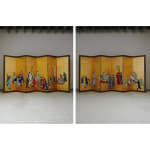Maruyama Ōkyo (1733–1795)
The Eight Immortals of the Wine Cup
Color, gold and silver on paper, pair of six-panel folding screen
Dated Meiwa 6 (1769)
Seals: Okyo no in; Chusen
171 x 379 cm each (overall)
Dated Meiwa 6 (1769)
Seals: Okyo no in; Chusen
171 x 379 cm each (overall)
Further images
-
(View a larger image of thumbnail 1
)

-
(View a larger image of thumbnail 2
)

-
(View a larger image of thumbnail 3
)

-
(View a larger image of thumbnail 4
)

-
(View a larger image of thumbnail 5
)

-
(View a larger image of thumbnail 6
)

-
(View a larger image of thumbnail 7
)

-
(View a larger image of thumbnail 8
)

Literature
Kokka no. 220. Tokyo: Kokkasha, 1908.
These screens depict eight heavy drinkers of the Tang dynasty from the poem “Eight Immortals of the Wine Cup” by the Chinese poet Du Fu (712–770). From right to left, the figures are He Zhizhang, Li Jin, Li Shizhi, Cui Songzhi, Su Jin, Li Bai, Zhang Xu, and Jiao Sui, aligned in the same order as they appear in the poem. We do not know of any other surviving paintings of “Eight Immortals of the Wine Cup” by Okyo, though we know of copies by Kunii Obun (1833–1887) and Kunii Oyo (1868–1923). Obun copied a 1774 work by Okyo that was inscribed with poems by Ike no Taiga. This work appears in an auction catalog in which four scenes can be identified through photographs. The imagery of this 1774 work is broadly the same as Eight Immortals of the Wine Cup by Yosa Buson (1716–1783), so it is likely that both were based on the same Chinese painting. Meanwhile, we do not know the format nor date of the Okyo’s work, which Oyo copied, but its design differs somewhat from the 1774 work, hence, Okyo may have based it on a different Chinese source.
The present work appears to be a developed version of Okyo’s missing work which was the original of Oyo’s copy. A noticeable change is that Cui Songzhi is shown standing; a posture possibly taken from Chinese paintings such as Court Lady (National Treasure, private collection). Su Jin’s posture embracing the desk with both arms is also different; it closely resembles the posture in Fu Sheng Expounding the Classics (Osaka Municipal Museum of Art) so there may well have been a Chinese painting resembling Fu Sheng Expounding the Classics in the Edo period, which served as a model.
The appeal of this screens, besides the novelty of the images, is the innovative style. The brushwork is restrained; the artist concentrates on expressing form, distinguishing the various figures’ postures and stances. The scene where He Zhizhang’s horse overlaps another figure draws the viewer’s gaze deep into the painting, in a manner reminiscent of Giotto’s murals. Okyo and Giotto’s realism, despite the obvious difference in scale, displays the same orientation.
Okyo’s signature gives a date of the eighth month of 1769. He was the second painter listed in the previous year’s Who’s Who in Kyoto [in the Edo Period] (Heian jinbutsu shi), showing that he was already in his prime. It is fair to say that in this pair of screens he has introduced every possible variation into his depiction of the Chinese figures. A figure of a gentleman like Li Jin later appears as Wang Xizhi or Guo Ziyi, whilst the figure of Cui Songzhi reappears in Portrait of Guo Ziyi (Mitsui Memorial Museum).
Maruyama Okyo (painter; 1733−1795)
Also known as Sensai; Chusen; Issho; Kaun; Senrei; Mondo.
Tamba-born late Edo period painter and the progenitor of the Maruyama School. Learned the Kano School painting technique under Ishida Yutei. Remarkably integrated the Chinese Song and Yuan dynasty painting techniques and the Western perspective method into Yutei’s shasei (direct observation from life) technique, and formed his distinctive style. Excelled at animal and botanical shasei paintings.
The present work appears to be a developed version of Okyo’s missing work which was the original of Oyo’s copy. A noticeable change is that Cui Songzhi is shown standing; a posture possibly taken from Chinese paintings such as Court Lady (National Treasure, private collection). Su Jin’s posture embracing the desk with both arms is also different; it closely resembles the posture in Fu Sheng Expounding the Classics (Osaka Municipal Museum of Art) so there may well have been a Chinese painting resembling Fu Sheng Expounding the Classics in the Edo period, which served as a model.
The appeal of this screens, besides the novelty of the images, is the innovative style. The brushwork is restrained; the artist concentrates on expressing form, distinguishing the various figures’ postures and stances. The scene where He Zhizhang’s horse overlaps another figure draws the viewer’s gaze deep into the painting, in a manner reminiscent of Giotto’s murals. Okyo and Giotto’s realism, despite the obvious difference in scale, displays the same orientation.
Okyo’s signature gives a date of the eighth month of 1769. He was the second painter listed in the previous year’s Who’s Who in Kyoto [in the Edo Period] (Heian jinbutsu shi), showing that he was already in his prime. It is fair to say that in this pair of screens he has introduced every possible variation into his depiction of the Chinese figures. A figure of a gentleman like Li Jin later appears as Wang Xizhi or Guo Ziyi, whilst the figure of Cui Songzhi reappears in Portrait of Guo Ziyi (Mitsui Memorial Museum).
Maruyama Okyo (painter; 1733−1795)
Also known as Sensai; Chusen; Issho; Kaun; Senrei; Mondo.
Tamba-born late Edo period painter and the progenitor of the Maruyama School. Learned the Kano School painting technique under Ishida Yutei. Remarkably integrated the Chinese Song and Yuan dynasty painting techniques and the Western perspective method into Yutei’s shasei (direct observation from life) technique, and formed his distinctive style. Excelled at animal and botanical shasei paintings.







